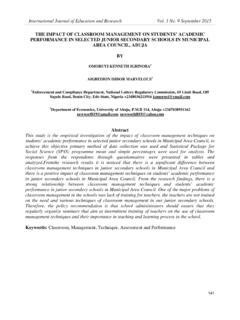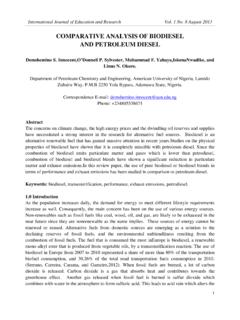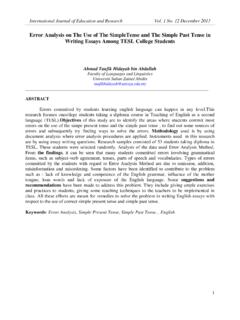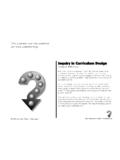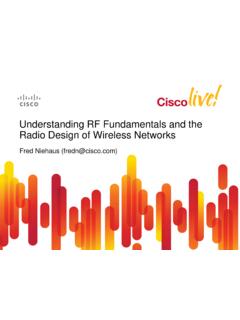Transcription of The Impact of Visual Arts in Students’ Academic Performance
1 International Journal of Education and Research Vol. 6 No. 7 July 2018 121 The Impact of Visual arts in students Academic Performance Jovita F. Punzalan Malolos City, Bulacan, Philippines, 3000 0917 276 10 86 Abstract arts have long been considered part of the human affective experience and needed by our young people as a medium for safe expression, communication, exploration, imagination, cultural and historical understanding. Thus, the challenge for Visual arts integration should not focus only on a particular art discipline alone like Humanities (Art Appreciation) somewhat it should extend across the curriculum.
2 The major problem of this study was to assess the Impact of Visual art on the Performance of the students from the College of Education, Bulacan State University. The study made use of experimental research design . Results of the study revealed that significant difference exists in the posttest performances of the experimental and control groups, in other words, the group who utilized the Visual arts in studying art appreciation recorded significantly helps Performance than those who used the traditional lecture-discussion method. Moreover, further analysis of data suggested that using Visual arts in different learning areas encourages students to participate and this will develop their confidence and advantage in the learning process.
3 Some pedagogical implications were drawn based on the findings of the study. Introduction: Globalization necessitates people from different continents to form connections despite having different norms and culture. It is imperative for the people of every country to understand one another along with their standards, and traditions. A way to achieve this understanding is through arts education. Through the arts education, people may learn to address and embrace diversity, present emotions and differentiate values in the world. arts education allows schools to provide the students with knowledge of ethics, see social realities and understand their rights and responsibilities.
4 ISSN: 2411-5681 122 Jolley (2016) in his article "The Importance of arts Education" recapped that arts education promotes some benefits in a variety of ways. Some of the advantages of arts education are: developing the students ' imagination and creativity; allowing them to understand and express their feelings and ideas; aiding them to understand and visualize other core subjects; helping them to observe the world around them; supporting them in the decisions- making and in solving problems; and in developing values such as concentration and persistence.
5 Ochshorn (2016) asserted that arts Education is important because it improves Performance . She claimed that it improved learning skills, school attendance, critical thinking skills and creativity. A good arts education is built on and reflects recognition of the specific and unique way that the arts shape people's thinking and their lives. Eisner, (2013). The noteworthiness of art is immeasurable and innumerable. Booth, D. (2016) asserted that the techniques are ways of learning, of exploring, of responding, of revealing and demonstrating, of imagining, and of depicting and making meaning. They belong to the school curriculum as they belong in the minds and hearts of lifelong learners.
6 For this matter, it is essential to conduct a study on how the Filipino students perceive the arts about their Academic Performance . This study aims to look into the respondents' perceptions and attitudes about Visual arts as predictors in the students ' Academic success. Many teachers integrate Visual arts into other content areas. Its inception in the elementary curriculum, arts education positively benefits students ' learning. Based on analysis of some relevant research literature, findings revealed that visuals positively Impact students ' behavior, engagement creativity, and Academic Performance . Education has been conceived as a continuing process of adjustment and experience.
7 In the 21st century, one of the goals of education is to open new windows that would make the skills and standards relevant to the Digital Age learners. It means developing students ' knowledge and higher-order skills; creativity, critical thinking, communication, and collaboration. In line with this goal, the Commission of Higher Education (CHED) sets an aim to upgrade the quality of Higher Education continuously; its programs and system to be at par with international standards. Higher educational institutions' faculties are advised to research in line with the goals of the Commission on Higher Education Research. Investigating the effective utilization of Visual arts in teaching Humanities (Art Appreciation) in the tertiary education is a reasonable undertaking, hence, this study.
8 The primary focus of this study is to investigate the effectiveness of integrating or using Visual arts in the teaching and learning Humanities (Art Appreciation). The study restricted its coverage to the 1st year Bachelor of Elementary Education students major in General Education of College of Education Bulacan State University School Year 2017 -2018 only. From the total population of 100 First Year students enrolled in the Humanities (Art Appreciation) course, 44 will constitute the sampling. The primary purpose was to identify the Impact of Visual arts or art integration in the students ' Academic Performance . This procedure guarantees that all subjects have the same chance of being in the experimental or control group.
9 The pretest-posttest control group design included pre and post-testing the subjects to measure the effectiveness of Visual arts or art integration in the students ' International Journal of Education and Research Vol. 6 No. 7 July 2018 123 Academic achievement. The analysis of the effectiveness was done through comparison of pre-oral and post oral communication skills results. The significance of differences was tested using the t the test of correlated mean procedures. Discussion: Eisner, E (2017) coined the term "cognitive pluralism" as among the orientations to the curriculum. This perspective highlights the idea that students should be afforded opportunities to learn and communicate their understandings through various forms of representation.
10 Lowenfeld (2005) published the book "Creative and Mental Growth" that describes the characteristics of child art at each stage of development and prescribes appropriate types of art media and activities for each age. His views of child art were grounded in constructs drawn from two sources. One was the psychoanalytic school of psychology in which evidence of aesthetic, social, physical, intellectual, and emotional growth is reflected in the art of children. The second was the concept of stages of growth in art, which originated in German and Austrian sources. Art Integration. According to Efland (2002), arts have long been considered part of the human affective experience.
